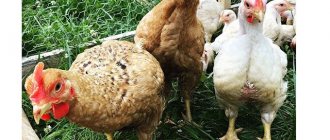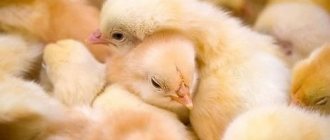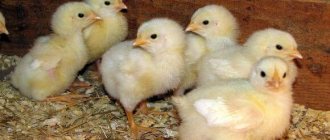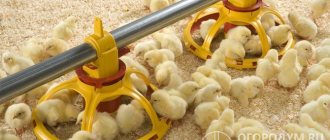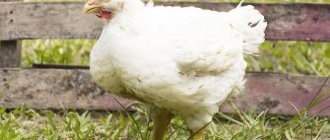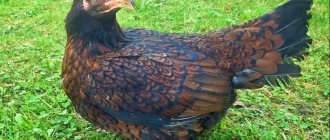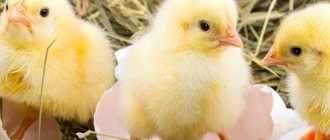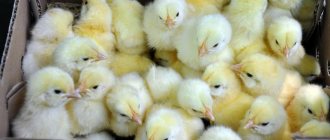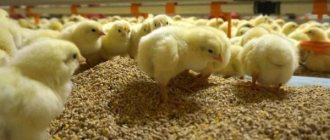Broiler chickens can be hatched independently from fertilized eggs purchased at a poultry farm, but this will require an incubator. You can purchase ready-made chickens, day old or older. If possible, it is better to buy chickens directly from the poultry house. This way you will be insured against dishonest dealers who sell chickens of less valuable breeds under the guise of broilers.
Beginners are often afraid to take day-old broiler chicks for fear of their death. Completely in vain. If simple conditions are met, babies grow quickly, and a single death occurs only when a weak individual is accidentally acquired. It is older chickens that can create a lot of problems for their new owners, since no one knows what conditions they were in during the first days or weeks of their lives.
Caring for Broiler Chickens
Let's look at the rules for caring for small broilers depending on age.
Day old chicks
These little ones must be kept at a temperature of +30-32°C and constant lighting. The drinking bowls should contain fresh, clean water, to which you can add a little potassium permanganate. Babies eat a lot and the most important thing is that each of them can freely approach the feeder.
The litter will have to be changed very often, perhaps twice a day. There is no point in being lazy here, because waste products cause increased humidity, and this is dangerous for the health of the chicks.
Week old broilers
After 7 days, the chickens will have grown and become stronger. Lighting should still be on 24/7. And only in the fourth week the lights are turned off for a while so that the young animals can rest.
The temperature should drop a couple of degrees every week. Otherwise the requirements do not change. The changes will only affect nutrition, but more on that later.
Month old broilers
If the chicks are one month old, then you have overcome the most difficult period in raising. The temperature during this period should reach +22°C. The lighting is turned off at night, daylight hours should be 14 hours.
Find out what to do if broilers are not gaining weight.
Change the bedding about every other day. Also make sure there are no drafts. Keep feeders and drinkers clean and wash them daily.
Video: raising broilers
Chicks at two months
At this age, the bird reaches a weight of 2 kg. These are almost adult individuals that are kept at a temperature of +18-20°C. Just as before, they need a clean and dry room, a sufficient amount of food and clean water.
What are the watering requirements for week-old broiler chickens?
watering broiler chickens from the first days
Free access to fresh and clean water of high quality plays an important role in the early life of broilers. With a lack of water, birds quickly become dehydrated and develop uric acid diathesis (gout), which can cause a sharp increase in the mortality rate 2-3 days after landing.
Chicks should be provided with clean, cool water immediately after placement. drinkers for broilers are used when planting . However, their use often results in water spillage onto the litter. Wet litter must be replaced immediately with dry litter. When hatchery processing and chick transport times are long, chicks become very thirsty at the time of chick placement. In this case, when drinking from open drinking bowls, many chicks become completely wet in the water. If wet chickens are not dried, they will certainly die from hypothermia. Bell and cup drinkers need to be washed every day (or even more often), cleaned of sawdust and replaced with water.
The use of a nipple system eliminates the described disadvantages. Special stainless steel nipples with 360º pressure can be used by chicks from the first minutes of entry into the house. The advantage for chickens is nipples with a wide pin, on which a large and clearly visible drop of water is formed. Chicks quickly find water and begin to use the watering system immediately after landing.
Shortly before the chicks arrive, the drinking line and any air pockets removed from it. By tapping or shaking the line, you need to ensure that a drop of water appears on each nipple, which will be noticeable to the chicken. To prevent the litter and birds from getting wet, drip eliminators under each drinker.
In the first days, you should not use cold water for drinking, as this can lead to hypothermia. However, the temperature of drinking water should not exceed 23-25°C. In order to maintain high sanitary quality of water in pipes, it is important to flush the lines when water withdrawal is minimal.
watering broiler chickens from the first days
During the starting period, it is recommended to use additional drinkers, even when nipple drinking is used. Additional drinkers should be washed regularly and filled with clean water to prevent contamination and bacteria.
Using a nipple with a wide pin creates a large droplet. Chicks easily find water and begin to use the automatic watering system immediately after being placed in the house.
The height of the drinking lines must be adjusted daily. In the first 2 days, it is necessary to install them so that a drop of water is at eye level of the chicks. Then, once the birds are fully comfortable with the equipment, the line can be raised so that the chicks are drawn towards the water at a 45º angle.
Profitability of broiler chicken breeding
When raising broilers, you need to calculate the maintenance costs and expected income in advance. Typically, the cost of each individual does not exceed 50%. But another main factor is the sales market. Where and to whom to sell slaughtered poultry...
Subject to the basic conditions of keeping and feeding, raising broiler chickens is quite profitable. Therefore, this trend in poultry farming is currently becoming increasingly popular among poultry farmers in different parts of Russia.
These are the important basics about raising broiler chickens at home for beginners from scratch. The topic is very broad. Over time, knowledge and experience will come. Start with proper feeding and conditions for broiler chickens!
Good luck!
Subscribe to site updates and our channel “Chicken” in Yandex.
See you later, colleagues! In the meantime, we will prepare new and interesting information for you!
See modern products for poultry and livestock farmers that improve the health of pets and make our work easier.
Mistakes of novice breeders
Although raising broilers does not present any particular difficulties, inexperienced owners do not always provide the chickens with normal living conditions. This leads to a decrease in productivity, and in some cases, to the death of birds. Common mistakes include:
| Failure to comply with temperature conditions | In an insufficiently warm room, chickens' immunity decreases. Exceeding the temperature norm causes lethargy and loss of appetite in birds. |
| Excessive humidity | Leads to the appearance of fungus and promotes the spread of pathogenic microorganisms. |
| Insufficient hygiene | Dirty feeders and bedding cause intestinal infections and intoxication with ammonia compounds. |
| Ignoring veterinarian recommendations | Saving on veterinary care can lead to significantly greater financial losses in the event of late or incorrectly selected treatment. |
How to Select Chickens for Personal Raising
It is advisable to buy chicks from breeders who specially raise them for sale in accordance with all norms and rules. The second option is to purchase from poultry farms and incubator stations. In both the first and second cases, you need to be careful and clearly understand for what purpose young animals are purchased, that is, which of the two indicators is more important - obtaining eggs or meat.
Choosing chickens for personal rearing
At what age should you buy chickens?
This question is quite important, since many producers sell day-old chicks at bargain prices. It is very difficult to raise such chickens to a safe age without special incubator conditions. Most likely they will die. The first seven to ten days of a chicken's life are characterized by maximum mortality. Therefore, it is best to buy ten-day-old young animals.
Rooster or hen
For meat broilers this is not a big deal, but if you want to choose, you can find out the sex at chick age by the wings. Spread your wing. A rooster's feathers will be the same size, while a chicken's feathers will be of different lengths. Regardless of gender, you need to choose chickens that are mobile, active, and have shiny, clear eyes. If the chicken is weak, sits all the time, and its eyes are cloudy, it is sick and will not live long
Healthy chicks respond well to sound. If you knock on the box or box in which they are placed, they will rush towards the source of the noise.
How to distinguish a rooster from a hen at an early age
Features of further care and feeding of chickens
The main condition is that the chickens always have water and food. It is allowed to score as early as 1.5-2 months. The weight of the carcass will depend on nutrition, living conditions, and breed. On average, the weight reaches up to 3 kg.
To fatten high-quality broilers, it is recommended to give them special feed that is considered balanced. Don't forget about food waste and bread crumbs. It is imperative to ensure that wet mixtures do not sour, otherwise this will lead to health problems. Cottage cheese, yogurt, and whey should be used as milk.
Selection of individuals for personal production
To acquire broiler chickens, novice poultry farmers do not have to start a breeding flock, but can purchase eggs from poultry farms. To simplify the task of hatching chickens and avoid many of the difficulties associated with this matter, you may decide to purchase already hatched livestock.
At what age is the best time to buy a bird?
This question always arises among beginning farmers who decide to acquire broilers. Without knowing all the nuances and buying day-old birds at very low prices, they often get into trouble.
This is due to the fact that day-old broilers are very difficult to raise without special conditions. The main part of bird mortality occurs in the first week of their life. That is why it is best to buy them when they are ten days old or more.
Rooster or chicken?
As a rule, sex does not play a special role in raising meat broilers, but if desired, it can be recognized even at one day of age. It is determined by its wings: the wing of a cockerel, when unfolded, has feathers of the same length, while those of a hen have feathers of different lengths.
You need to choose active and mobile chicks. Healthy individuals have clear eyes, good fluff, and a soft, non-bloated belly. Healthy chickens respond well to sounds.
When to buy?
Depending on the conditions of keeping broilers, there are 2 types of their rearing:
- Extensive. In this case, a batch of chickens is purchased (hatched) in the spring and kept until mid-summer. In mid-summer, when the birds have reached marketable weight, they are slaughtered. The method is seasonal.
- Intensive. Lots are purchased every 3 months, all year round.
Prevention and treatment of diseases
As you know, prevention is the best way to prevent broiler disease. Therefore, the main and main rule will be to carry out disinfection measures in the room where the chickens live. Cleanliness prevents the occurrence of various types of infections. For the smallest broilers, it is recommended to immerse their feet in a disinfectant solution for 3 days. Experienced poultry farmers advise giving chickens from 3 days of age Enrofloxacin solution at the rate of 1 cube per liter of water.
To strengthen the immune system, broiler chickens are given water with ascorbic acid dissolved in it (1 packet per 3 liters) - this will compensate for the lack of vitamin C in the body. Vitamin supplements such as Chiktonik, Biovit, begin to be given at the age of seven days for prevention of vitamin deficiency. The duration of taking vitamins is 10 days.
Among young broilers, the concept of cannibalism (popularly “pecking”) is often encountered. In order to avoid such trouble, you should carefully monitor the behavior of the chicks. The main causes of pecking can be considered too bright light, close housing of chickens and a lack of protein or gravel in the diet. In the event that pecking does occur, it is necessary to add a little citric acid to the drinking water (acidify), anoint the wounded chicks with brilliant green and place them separately. Otherwise, pecking may continue - curious chicks will peck at the green crown.
Business Features
Strictly speaking, broiler breeds do not exist in nature. This is the name of hybrids obtained under artificial conditions by crossing the most productive meat species - Cornish males and White Plymouthrock females. Therefore, raising crosses for the sake of obtaining hatching eggs is useless: the very first generation of chickens completely loses the unique characteristics of their parents.
The main difference between hybrids is their enormous growth rate: already at one and a half months they weigh 2.2–2.5 kg, which is five times higher than that of ordinary chickens. As a result of this acceleration, broiler farming as a business has some important features that distinguish it from other areas of poultry farming. In particular:
- In the selection of crosses, the determining factor is the growth rate. Therefore, poultry often have weak immunity and low resistance to disease;
- The productivity of the species is manifested only when special feed is used. Chickens fed on food waste and grain gain weight no faster than regular chickens;
- The time frame for raising broilers at home is limited to two to three months. Further weight gain does not justify the consumption of feed;
- To speed up growth, the bird's mobility is limited, depriving it of walking. In cramped cage conditions, it is necessary to constantly monitor the health of the livestock;
- A group of grown chickens is slaughtered in just a few days. At this point, you need to have agreements with buyers so that the carcasses do not spoil.
Features of breeding broilers at home are determined by the purpose of entrepreneurial activity. A farmer can raise poultry to sell grown chickens to summer residents or to sell meat:
- When selling chicks, you do not need spacious premises or cage batteries. You can also do without purchasing growth and finishing feed;
- When breeding broilers at home, they buy eggs or week-old chickens for meat. In the second case, you can save on incubators.
Use of feed for broilers
For more intensive growth of broiler chickens, feeding and rearing at home, it is recommended to use specialized feed, which can be purchased ready-made or prepared by yourself. This feed fully meets all the physiological needs of broilers. This diet brings especially high results in the first four weeks. Ready-made feed for broilers varies in composition and particle size. For ease of perception, we present information about the necessary feed in the form of a table.
| Ingredients, % | Compound feed "Broiler Start", grams | Compound feed "Broiler growth", grams | Compound feed "Broiler Finish", grams |
| Peas | — | 4 | 5 |
| Sunflower cake | 8 | 13,7 | 18 |
| Corn | 10 | — | 19,8 |
| Chalk, calcium, phosphate | 0,8 | 0,33 | 0,24 |
| Blood meal | 2 | — | — |
| Wheat | 45 | 40 | 26 |
| Shell + chalk | 1,7 | 1,67 | 1,76 |
| Salt | 0,33 | 0,3 | 0,2 |
| Soya extruded | 9,4 | 24 | 18 |
| Soybean meal | 16,8 | 3 | — |
| Barley | 5 | 12 | 10 |
Feeding broilers with wet mash
Wet mash is very useful for broilers and convenient for fattening chickens. They are a mixture of several ingredients.
As a rule, these are grains brewed in water or broth. They are needed primarily only for newborn babies, whose bodies are not yet ready to digest other, coarser foods.
Wet mash for fattening has the following advantages:
- quickly and for a long time saturate the body of chickens,
- provide replenishment of the need for various microelements,
- you can quickly prepare mash from food waste,
- low cost of such feed.
What is mash used to prepare broiler fattening? The mash includes:
- hay flour,
- cereal grains,
- fresh vegetables - potatoes, beets, carrots, pumpkin.
- In the summer, greens are added, and in winter, fish oil is added.
The liquid base is whey, water or skim milk. It should be no more than a third in relation to other products.
The feed can be mixed manually or mechanically. The consistency should not be too liquid.
When choosing the composition of the mash, it is important to take into account the age of the chickens, as well as the goals pursued - obtaining meat or eggs
- Laying hens require more calcium, so eggshells are added to the mash.
- Meat breed chicks need proteins found in eggs, meat and bone meal, which means more of these components need to be included in the mash.
Growing in a free-range chicken coop: pros and cons
This growing method also has not only advantages, but also disadvantages. The positive aspects of the floor method include the following points:
- natural conditions of detention;
- minimal injury;
- normal development of the musculoskeletal system;
- good quality meat;
- minimal stress for the bird;
- strong immunity, high resistance to diseases and infections, no problems with metabolic processes;
- obtaining additional natural pasture;
- getting enough sunlight;
- minimal maintenance costs;
- minimal probability of improper conditions of detention.
The disadvantages of such cultivation are not always high-quality sanitary and hygienic conditions and a high probability of spreading infection.
Features of cultivation
Breeding broilers at home for beginners is possible using two methods:
- Extensive.
- Intense.
Let's figure out what their differences are. In the first case, raising chickens at home is carried out seasonally. Young animals are purchased in the spring and sent to slaughter by mid-summer. In winter, the bird does not breed.
In the second case, the bird is bred all year round. Young animals are purchased every three months. Poultry is sent for slaughter 1.5–2.5 months after purchase.
If you plan to breed broilers in your country house, you need to evaluate the available area for keeping the birds. Taking into account this area, birds can be bred in two ways:
- Outdoor breeding.
- Cell breeding.
Outdoor breeding
For floor breeding of broilers, more space is needed than for cage breeding. They can be placed in a small building. If you plan to raise poultry all year round, you need to take care of insulating this room. You can use heating devices.
Rules for keeping poultry outdoors that must be followed:
- The floor in the poultry house must be covered with a layer of lime. A 10-centimeter layer of sawdust is laid on top of it - this material absorbs moisture well and is quite economical.
- For day-old chicks, the house must be illuminated 24 hours a day.
- The room must have good ventilation.
- For the first 2 weeks of a bird’s life, the house must have an appropriate temperature – no less than +26 and no more than +33 degrees.
- Birds that have grown up to one month of age are kept in the house at a temperature of +18 to +20 degrees.
- The humidity level in the chick room is maintained at 65–70%.
The bird is very sensitive to changes in temperature, especially if we are talking about sudden changes. Therefore, its indicators need constant monitoring
More attention should be paid to this point in winter, when the ambient temperature is low.
Cell breeding
Keeping broilers in cages is the best option when the area used is small. Cages can be placed in one tier or in several, which is important for breeding large numbers of birds.
The advantage of keeping young animals in cages is the savings on bedding materials. Since this bird is inactive, it easily gets used to limited space. Therefore, the cells do not need to be made too large. One square meter can accommodate 18 chickens or 9 adults.
When raising poultry in cages, it is necessary to adhere to the recommended temperature regime - from 34 to 35 degrees. Ventilation must be provided in cages. In all other respects, the requirements for cage breeding of broilers do not differ from floor keeping.
Breeding broilers in an incubator
Breeding broiler chickens at home is also possible by laying eggs in an incubator. This will reduce the cost of purchasing young animals.
In order for the offspring to be healthy, it is necessary to choose the right eggs to put into the incubator chamber. To do this, it is recommended to take them from chickens whose age does not exceed 2 years and does not suffer from infectious diseases. It should be noted that sexual maturity of this type of poultry occurs no earlier than 7–8 months of age.
Requirements for eggs for incubation:
- The average size. If you take small eggs, then there is a high probability that the young ones will not be distinguished by their large weight and size. In the case of large eggs, you may encounter damage and cracks in the shell. This happens because the shells of large eggs are not strong enough.
- Correct form.
- Same weight.
- Uniform color.
All this time, the eggs are stored in a cool, dark place. The incubation period lasts 21 days.
Despite the fact that female broilers are weak layers of eggs, they are good brood hens. Therefore, they can quite cope with hatching offspring. Only in this case the number of chicks hatched will be significantly less than in the case of an incubator.
Growing in cages: pros and cons
Cage housing of broilers has both advantages and disadvantages. The advantages include the following:
- saving space and building materials for arranging a chicken coop and bedding;
- arrangement of cells in several rows;
- optimal sanitary and hygienic conditions of detention;
- high planting density.
The disadvantages include purchasing special cells and maintaining the same temperature in all rows of cells.
How to choose broiler chickens when purchasing
The right choice in our business is perhaps the most important thing. If you are a beginner, then be careful when purchasing, because they may try to pass you off the most ordinary chickens as broiler chickens.
It will be useful for you to read about what broiler chickens look like, as well as what the weight norms for broilers are at all stages of life.
Therefore, it is best to purchase material from trusted manufacturers, preferably from a poultry farm. There is a guarantee of the purity of the breed and relevant documents. If anything happens, you will know where to file a claim.
When purchasing young individuals, pay attention to the following appearance details:
- chicken legs are movable, without bending or damage;
- eyes - shiny, not clouded;
- the beak is smooth, light yellow, with a regular shape.
Did you know?
“
broiler
”
itself comes from the English verb “to broil”, which means “to fry”.
And all because chicken meat is the most tender and tasty when cooked. Experienced poultry farmers recommend the following breeds that have proven themselves:
ROSS-608 is considered simply unique because it is devoid of serious shortcomings. She is distinguished by light skin and short stature, weight gain per day up to 55 g.
COBB-500 is an excellent breed, not picky about food. The bird has an interesting feature - yellow skin color, which attracts buyers.
BROILER-M is not only a meat bird, but also an egg one
It has a small build, which is important when saving space.
BROILER-61 is a four-line cross (a mixture of four breeds), with a good taste of meat. Among the disadvantages is that you need to limit food, otherwise the bones will not withstand much weight.
GIBRO-6 is also a four-line cross, its characteristics are very similar to the BROILER-61 variety.
SMENA - a very popular cross, has tasty meat and eggs, good survival rate
Disadvantage: they are very sensitive to the temperature at first.
Did you know? It turns out that currently the weight gain in chickens is 4 times higher than that of their predecessors in the mid-20th century. Scientists from Canada at the University of Alberta found this out.
Choosing the optimal breed
Almost all broiler crosses are the result of hybridization of highly productive meat chickens. They have a strong skeleton and in most cases white plumage. The average daily weight gain of chickens is 80 g. The most productive broiler breeds include:
- ROSS-308 and 708;
- COBB-500;
- Hubbard F-15;
- Gibro-6;
- Broiler-61.
Among owners of private farms, birds from the Smena line are very popular. When choosing a specific breed, it is recommended to focus on its productivity indicators, adaptability to the climate of your region and the cost of chickens.
Broiler care
There are two main methods for raising broiler chickens:
- Extensive;
- Intensive.
The choice of method depends on the conditions that the owner of a private farm can provide for his birds.
In the first case, broiler chickens are purchased in the spring and raised until mid-summer until they reach marketable quality. Once these qualities have been acquired, the entire batch of poultry is slaughtered. Breeding is suspended until next season.
In the second case, a new batch of broiler chickens is purchased every 3 months throughout the year without interruption. Cultivation occurs all year round and is not seasonal.
When raising chickens, you should pay attention to the fact that if you keep the bird for longer than 70 days, it will no longer be economically profitable. Poultry can be raised in cages or on the floor on bedding.
Let's take a closer look at both options.
Poultry can be raised in cages or on the floor on bedding. Let's take a closer look at both options.
Contents on the floor
Here, special attention should be paid to the filling on the floor itself, or rather, to its composition. The litter should be loose, dry and absorb all harmful gases
The best option would be dried sawdust from wood without large chips and bark.
Arrangement of the premises:
First, the floor must be covered with quicklime powder in an amount of 1 kg per 1 sq.m of area; A layer of dry sawdust at least 10 cm thick is poured on top of the lime; If the chickens are monochromatic, then care must be taken to ensure there is round-the-clock lighting in the room; Good ventilation is also necessary;
It is worth taking care of the temperature in the room. In the first 15 days of keeping chicks, the temperature should be 26-33 degrees
It is important to ensure that the temperature does not drop at night; After 30 days, the temperature can be reduced to 20 degrees. The temperature should remain approximately at this level throughout the entire growing period; It is also necessary to comply with the conditions regarding air humidity
For young chickens this figure should be no more than 65%. After 20-30 days, the humidity can be increased to 70%.
It is worth paying attention to the fact that electric heaters will be needed to maintain the required temperature in the room in which the chickens are kept.
Contents in cages
If broiler chickens are kept in cages, then it will be necessary to adhere to other standards and conditions. More than 20 birds cannot be kept in one cage, and the requirement for the number will not change with the age of the broilers.
The cages can be arranged in several tiers, which will significantly save space in the room. In each tier, certain temperature standards must be observed - the temperature should not fall below 35 degrees, since chickens in cages do not have the opportunity to calmly move around and look for a warmer place, unlike chickens that are kept on the floor.
There is no need to lay bedding in the cages, but they must be cleaned and disinfected regularly. Sanitary and epidemiological stations give greater preference to keeping birds in cages rather than on the floor, as this is hygienic and safe for both chickens and humans.
The room where the cages are located must also have ventilation.
These are the care requirements that must be observed when keeping broiler chickens at home. Now it’s worth familiarizing yourself in more detail with the rules of feeding poultry.
Diet of one month old broilers
From this age, young animals are prepared for slaughter and transferred to finishing feed. The number of meals is reduced to 3 times, while simultaneously increasing the calorie content of the diet and limiting the birds' movement. Serving size increases by 20 g every 2 weeks. Feed mixtures for broilers can contain coarse grain and granulated mixtures of large fractions. The composition of the products remains the same, but the ratio of components changes. The percentage of proteins decreases, and the amount of carbohydrates increases.
2 weeks before slaughter, fish and its processed products are excluded from the chicken diet. If this is not done, the quality of the finished product will deteriorate due to an unpleasant specific odor. The last feeding is carried out 6-10 hours before slaughter. Fasting is necessary so that the food eaten has time to be digested and does not affect the taste of the meat.
What and how to feed broilers
In the photo - broiler chickens near the feeder
The most important issue is the issue of feeding broilers. The speed of weight gain and the quality of chicken meat depend on the correct diet and adherence to the required regime. Also not the last parameter is the amount of food costs.
In the first days of life, young meat broilers are fed in the same way as chickens of egg-laying breeds. Then the style, quality and regularity of feeding change.
Table 2. Procedure for feeding broiler chickens.
| Age | Feed |
| From the first to the third day of life | The main food is a whole boiled egg (yolk and white). Chickens need a lot of protein in the first days of life. Milk and cottage cheese can also be its source. |
| Starting from the third day | Fresh chopped greens (grass, nettle leaves) are added to the diet. You can replace it with grass flour if growing occurs in winter. Another option is to replace it with sprouted grain (barley). Fresh grass in the diet can be up to 20% of the volume, sprouted grain - 10-15%, but grass meal should be given no more than 5 g per day per individual. It contains a lot of fiber, which is slowly absorbed by the chicks’ body. |
| On the fifth day | Minerals are being added to chicken feed. These include bone meal, crushed shells or chalk. There should be at least three grams of minerals per chicken per day. From now on, eggs can be given with their shells (crush). |
| On the fifteenth day | You can include grated carrots and boiled meat in your diet. Cereals appear in the diet - millet (millet), oatmeal, crushed wheat, fine crushed barley, corn grits. Grain makes up at least 60% of the total nutrition. |
| From three weeks of age | 20% of the grain requirement is replaced with boiled potatoes. All components of the diet are mixed into a wet mash. Wet feedings alternate with dry grains. |
| From the second month | The amount of protein feed decreases, and the volume of juicy, herbal components increases. |
Broilers need to be fed a lot, in plenty, often. If they eat a balanced diet, they are not in danger of becoming overly fat.
- In the first week of life, feeding should be eight times a day.
- From the second week you can switch to six meals a day.
- From the third week you need to feed four times.
- From one month until slaughter, chickens are fed twice - in the morning and in the evening.
Chicks should not be given raw water until they reach two weeks of age; it must be boiled. It’s better to add a weak decoction of chamomile or rose hips to the drinking bowls for a beneficial effect on digestion.
The photo shows growing broiler chickens
Each little chick needs at least 40 ml of water per day. If there is not enough fluid, broilers become dehydrated, which requires therapeutic intervention from a veterinarian.
Useful information about feeding with compound feed
Compound feed is the main element of nutrition for broiler chickens on all poultry farms and poultry farms. In private farmsteads, when growing in chicken coops and cages in small batches, for personal needs, without special conditions, feeding with compound feed may not be justified.
- Firstly, during industrial cultivation, feed rates are strictly dosed.
- Secondly, for each age of chickens, a certain type of feed is selected, with different percentages of nutrients, in accordance with the immediate needs of the chickens’ body.
- Thirdly, when fattening at poultry farms, young animals are weighed weekly in order to calculate the dose of feed they need for the next week
Of course, all these manipulations are also possible when raising broilers at home, but they can cause some difficulties. Therefore, it is not advisable to feed chickens with compound feed.
Stern
Broilers are characterized by very fast growth, efficient feed utilization, low fat content, high muscle to bone ratio, good meat quality.
Broiler chickens have a short digestive tract and fast metabolism, and therefore have high nutritional needs.
To produce a 1.35 kg broiler you need approximately:
- 4-5 weeks
- 2.5 kg of feed.
Fattening of broiler chickens is divided into 3-4 phases during 5-7 weeks of growing. The stages differ in the composition of the diet:
- at the first stage of feeding, chickens need a lot of protein per serving of feed (21-23%);
- at the final two stages, a high energy content is required (up to 13.4 MJ/kg).
Sometimes the average feed in terms of energy and protein is used throughout the fattening period, but the system of dividing the feed into phases and various mixtures is more effective.
Composition of feed mixtures
Broiler chicken mixtures are usually cereal based:
- wheat,
- triticale,
- barley,
- oats.
The use of rye is not recommended. Even a small addition of rye grain can cause diarrhea in chickens.
Compound feed for broilers often contains:
- by-products of grain grinding - feed flour, gluten, wheat germ;
- feed fats – vegetable oils, beef fat;
- pork, fish.
Feed may contain oilseeds - rapeseed, soybeans, and their post-extraction flour. The protein deficiency in the mixtures is compensated by the addition of high-protein seeds of narrow-leaved lupine and peas.
The list of ingredients of the mixtures includes additives:
- dry extracts;
- yeast;
- dry green food (from young grasses and alfalfa);
- fish flour;
- dairy products (milk powder, whey).
An important role in poultry feeding is mineral ingredients used to supplement micro- and macroelements. Commonly used:
- feed chalk;
- calcium phosphates;
- feed salt.
Most commercially available feeds contain feed additives designed to:
- replenishing the lack of certain ingredients (proteins, amino acids, vitamins);
- digestive support (feed enzymes);
- improving the digestibility and consistency of feed;
- reducing the toxicity of bird droppings;
- prevention of diseases (prebiotics).
Broiler chickens in the chicken coop must have constant access to feed and water.
Compound feed
Intensive rearing of broilers involves the use of modern feed in the diet. There are many types of food from different manufacturers.
In general, modern food is divided into:
- starters (for young chickens);
- basic (basic weight gain);
- finishing (used at the final stage of cultivation).
Table. Approximate calculation of the use of feed for broilers
| Feed group | Feeding period, days | Features of use |
| Starting | 0-10 | Should be given as soon as the chickens move into the coop. Birds should have easy access to water. |
| Grower I in crumb form | 10-24 | Used when birds reach 250-350 g body weight. Earlier use leads to excessive fat content and metabolic disorders, especially in the last period of fattening. |
| Grower II in granular form | 25-35 | |
| Finishing | last 7 days of growing |
Proper storage of feed
Chickens are good at recognizing feed quality, which can limit feed intake. Various factors affect broiler feed acceptance, including lack of palatable ingredients in the mixture, but the biggest problem is mycotoxins, which should be avoided. Mycotoxins are produced by some types of fungi and molds under appropriate conditions:
- temperature 20-25 °C;
- high humidity.
Toxic molds thrive in damp grain storage and are often carcinogenic and mutagenic organisms that cause anorexia in broilers.
Mycotoxins contribute to various diseases:
- acute and chronic intoxication;
- cause allergies;
- mycoses;
- diseases of the gastrointestinal tract and liver;
- numerous diseases associated with a weakened bird’s immune system.
It is very important to prevent diseases:
- store food correctly
- carry out periodic disinfection of storage facilities.
Granular or bulk feed - which is better?
Using granulated feed has a number of advantages:
- due to its homogeneity and high density, it allows you to consume it in larger quantities per unit of time - this ensures maximum productivity;
- accelerates the growth of broilers;
- granules do not spray, do not separate during storage and transportation - the feed is less contaminated with microorganisms;
- By consuming granulated feed (more energy-rich than bulk feed), broilers receive more energy and rest longer.
Maximum feed intake is achieved by feeding high quality pelleted mixtures.
However, the energy value and efficiency of use in broiler fattening depends on the quality of the granules.
The small size of the granules may reduce their taste.
Feed additives
Most feed additives used in feeding broiler chickens are also effective in pigs, both species are monogastric animals. A well-known phytase enzyme works in poultry and pigs, but most supplements are more effective in poultry, especially broilers.
Although very similar, the gastrointestinal tract of broilers is not the same as that of pigs. Therefore, the use of feed additives for chickens has its own peculiarities.
Finely ground feed improves the feeding efficiency of pigs, but disrupts digestion in broilers.
Some additives are most suitable for broilers, such as butyric acid.
Feeding week old chicks
If feeding chickens in the first days of life involves using a minimum set of products, then when they reach a week of age, the birds need a more varied menu. At this time, it is time to accustom the young animals to mash prepared from various cereals.
All components for such food should be taken in equal proportions. Fermented milk products and greens should be given as additional useful nutrition.
To make care and feeding more effective, at this age it is necessary to introduce vitamin and mineral supplements into the diet. Their use is especially important for raising chickens hatched in an incubator. Such supplements will help young animals be healthy and energetic.
Also, feeding broilers implies the constant presence of clean water in the cages for drinking. Regardless of breed, chicks need plenty of fresh fluid. The water should be changed frequently to remove any accumulated debris from the drinkers. Week-old Brama chickens and, for example, Loman Brown will be healthy and strong only if they have enough food and drink.
Nutrition
Broilers can be fed with factory-produced combined feeds or mixtures prepared at home. Despite the fact that industrial feed has a carefully balanced composition, enriched with vitamins and microelements, there is an opinion that the meat of home-raised broilers is much tastier. When preparing feed mixtures yourself, you should pay attention to the quality of the ingredients.
All components must be purchased in specialized stores, since grain purchased from hand may be contaminated with insecticides.
Diet
Compound feeds for broilers are divided into three age categories:
- starting – from birth to two weeks;
- growth – from 14 to 30 days;
- finishing – from 30 days before slaughter.
Diet for broiler chickens.
If the chickens hatched at home, in the first hours, they can be given finely chopped egg yolk. For further feeding you need to prepare a mixture of the following composition:
- finely crushed corn grains – 50%;
- crushed wheat – 16%;
- Sunflower cake – 14%;
- barley – 8%;
- kefir or yogurt – 12%.
To increase the calcium content, you need to add a little chalk or shell powder. Finely crushed eggshells are often used for this purpose. Proper development of chickens is impossible without vitamins, which should also be added to the feed mixture. You should not prepare a large amount of food at once. A supply of two days will be sufficient.
This material will tell you about the shell for chickens.
When the chickens reach two weeks of age, the composition of the cow mixture changes slightly. The new diet should stimulate the body to actively gain muscle mass. The basis of the feed mixture remains the same, but the percentage composition changes and new products are added. This food is called growth food and contains the following products:
- crushed corn – 48%;
- sunflower cake or meal – 19%;
- crushed wheat – 13%;
- bone or fish meal – 7%;
- yeast – 5%;
- fresh herbs – 3%;
- milk powder – 3%;
- feed or fish oil – 1%.
Greens should be finely chopped and added just before feeding. During this feeding period, chickens can be given wet mixtures prepared with milk, kefir or yogurt.
When broilers reach 30 days of age, they should be switched to finisher feed. During this period, the most intense weight gain occurs and the taste characteristics of the meat are formed, so the feed changes again. The birds have grown enough that the grain crops do not need to be crushed too finely. One of the finishing feed options looks like this:
- small corn – 45%;
- wheat – 13%;
- sunflower or flaxseed cake – 9%;
- meat and bone or fish meal – 8%;
- barley – 8%;
- yeast – 5%;
- fish oil – 3%;
- greens – 1%.
For the proper development and strengthening of the immune system of chickens, vitamins must be added to the feed mixtures. To do this, it is convenient to use the multivitamin preparation “Trivitamin”, which is an oil solution of vitamins “A”, “D3” and “E”. It can be purchased in specialized stores for farmers.
When rearing at home, starting from the age of one month, chickens can be given cabbage leaves and beet tops, as well as melons . You can steep grain products in bone broth and then add potatoes and beets.
You cannot immediately give broilers new products in large quantities. This can lead to intestinal disorders. Each type of feed should be introduced gradually, observing the reaction of the chickens’ body.
Feeding standards
There are certain norms for feed consumption, depending on the age of the chicken. From birth to two weeks, chickens consume from 10 to 25 grams of feed per day. After two weeks of age, chickens' appetite increases significantly and they require up to 120 grams of mixed products. At the final stage of fattening, fairly large individuals consume about 150 grams of feed per day. At this stage, birds gain over 50 grams of weight per day. In addition, the number of feedings varies depending on age.
- first week - every two hours or 8 times a day;
- second week – 6 times a day;
- third week – 4 times a day;
- from the fourth week until slaughter - 2 times a day.
Vitamins
Vitamins for broiler chickens play a vital role. They activate biochemical processes in the body, organize proper metabolism and help increase immunity. When adding vitamins to feed mixtures, it is necessary to strictly maintain a balance, since an excess of vitamin preparations can lead to more negative consequences than their deficiency. Pharmacy vitamin complexes can be given to chickens starting from the fifth day.
When feeding broilers at home, you can use not only ready-made vitamin preparations, but also vegetable crops that contain large amounts of vitamins necessary for chickens. Most often, green onions are added to the food. It destroys pathogenic intestinal microflora and stimulates metabolism. In winter, onions can be grown on a windowsill without any problems. In spring, sorrel is very useful for broilers. In addition to useful biologically active substances, it contains vitamins of group “B”, “C”, “E” and “PP”. Popular vitamin complexes include the following drugs:
- trivit;
- tetravit;
- aminovital;
- Chiktonik.
All of these drugs are combined vitamin mixtures that should be added to broiler feed.
Read about growing Cobb-500 broilers at this link.
Chiktonik
"Chiktonik" is a complex preparation containing a set of all necessary vitamins and amino acids. It is added to drinking water in an amount of 1-2 ml per liter. The recommended course of treatment for broilers is 5-7 days. The use of the drug is especially useful in winter, when the chickens’ immunity is weakened.
Chiktonik is a veterinary drug for broiler chickens, laying hens, and adult poultry.
Taking the drug allows you to achieve the following positive results:
- accelerate weight gain of broilers;
- significantly improve immunity;
- restore the bird’s body after illness;
- stimulate good appetite.
When using complex vitamin preparations, you must strictly follow the instructions for use and avoid overdose.
Raising broilers at home from 1 day for meat
From the first 14 days of a chicken’s life, their future productivity is determined. Therefore, during this period it is especially important to provide them with good living conditions, proper nutrition and care.
When raising broiler chickens, it is necessary to distribute them evenly throughout the house. If they are kept in brooders (special boxes), they cannot be stacked on top of each other. This must be done in one line.
For uniformity of the herd and further fertility, it is necessary to de-beak the males as accurately as possible, that is, cut off only the tip of the beak, which is orange. This will ensure the safety of the hens, and will also make the mating process easier overall. If broiler chickens still have long or deformed beaks by the age of one month, the procedure must be repeated.
Bettas should be actively gaining weight until they are 16 weeks old. This will be a deciding factor for their future size. After 18 weeks of age, birds need to be fed so that they maintain their live weight and their testes develop normally. If they are formed incorrectly, males will have poor reproductive function.
Diseases
Newcastle disease
The most common diseases that affect broilers are:
- Bronchopneumonia is a non-contagious disease. Causes: hypothermia, previous infection.
- Newcastle disease (pseudoplague) is an infectious disease.
- Mycoplasmosis is an infectious disease.
- Aspergillosis is a fungal disease.
- Salmonellosis is an acute infectious disease.
- Pullorosis (chicken typhus) is an infectious disease.
- Bird flu is a viral disease.
- Chicken pox is a viral disease.
How to grow using an incubator
Eggs no older than 3 days are suitable for raising chickens in an incubator. Before placing them in the device, you need to adjust the temperature mode:
- First week. Optimal mode +38.5…+39 degrees. After placement, the eggs must warm up for a day, after which they are turned. Then they move regularly (those from the sides are moved to the center and vice versa).
- From day 19 there is no need to turn over. The temperature should be +37 degrees.
- On the 20th day the chicks will appear. On day 22 they can be pulled out of the incubator.
Expert opinion
Firsov Sergey Arkadevich
Poultry farmer
Note! For hatchery chicks, you need to arrange dimmer lighting.
